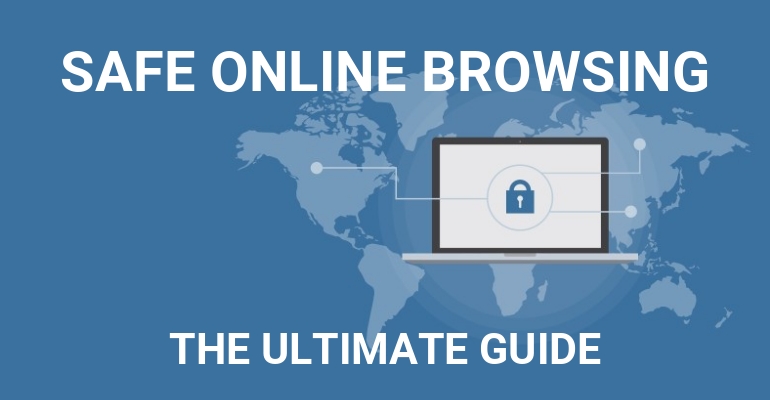[mc4wp_form id=”2320″]
How to Browse the Internet Safely
-
September 28, 2023
- Posted by: Abelemkpe

How do you browse the internet safely? How safely do you use technology in your daily life? Countless threats are trying to find new ways of compromising your devices, where your personal information is stored. A successful cyberattack means serious damage to your devices. Don’t let the internet be an unforgiving place for you. Learn here how to browse the internet cautiously and prevent becoming a victim of cyber danger.
Why is internet safety important?
There is no doubt that the Internet makes our lives easier. But it’s also threatening us with spam, identity theft, invasion of privacy, and cyber espionage. This is why internet safety (also known as online safety or e-safety) is important. Internet safety means being knowledgeable about the nature of the potential threats that you could face while browsing the Internet. It is time for you to focus on the positive aspects of digital life and learn safe web browsing security tips.
How to browse the Internet safely
We have collected 10 best practices you can follow for smart browsing on the internet.
1. Update your web browser
Running an outdated version of a web browser is equivalent to missing out on some of the newest features. Updating your browser lets you use the latest security measures, and updated browsers get better at identifying threats and blocking unwanted popups. Ignoring to update can result in your browser being infected to get information from your search history. Check for any available updates in your browser and stay up-to-date.
2. Choose strict privacy and security settings on your browser
Many people fail to optimize their browser’s security settings. But it is a vital step in using the Internet privately. For enhanced privacy and security settings, consider the actions below:
- If you’re using Safari (Mac), follow this: Preferences > Privacy tab and select ‘Prevent cross-site tracking’
- For Firefox: Preferences/Options > Privacy & Security > Content Blocking > Check ‘Always’ under “Send websites a “Do Not Track” signal that you don’t want to be tracked.”
- For Google Chrome: Settings > Advanced > Content Settings > Pop-up and redirects > Turn on “Blocked under Pop-ups and redirects”
- For Microsoft Edge: Settings > Privacy, search, and services > Balanced
- For Internet Explorer: Tools > Internet Options > Privacy tab and set the slider to Medium. Check the “turn on pop-up blocker” box
- For Vivaldi Browser: Settings > Privacy > Cookies > Under ‘Third-Party Cookies’, check ‘Block Third-Party Cookies’
3. Stop visiting websites without HTTPS
HTTP is a protocol for computers, but it’s not encrypted. HTTPS is another protocol, and it is encrypted using Secure Sockets Layer (SSL). If browsers use HTTPS to pass information, even if nosy sniffers access the data, they can’t read the information. As a user, make sure that the websites you visit are secure. Pay attention to the left side of the web address: lock sign means a secure connection; an exclamation mark says the connection is not secure; an info sign means the site isn’t using a private connection.
4. Be careful what files or applications you download
As humans, we love downloading games, applications, images, and music. Because they’re fun and sometimes give us excitement. Next time, don’t carelessly download applications or attachments for the sake of fun. Such an action can be the source of a virus or malware infection. To avoid a nasty surprise, download your applications only from reputable sources. Also, scan files for viruses before you click on them. If you’re worried that a file might be unsafe to download, you can cancel the process in the download toolbar.
5. Delete your browser cookies
You visit tens of websites every day. These websites create small bits of code to gather data from your browsing history. In some cases, cookies can be useful (for example, when saving site login details), but they undermine your privacy. Did you know that intruders could steal cookies to access your accounts? Remember the Yahoo data breach that occurred in 2015? Hackers used an advanced cookie forging attack and hacked 32 million accounts. Yes, 32 million. And without having to use a password. To delete your browser cookies, see the actions below:
- For Safari (Mac): Preferences > Privacy > Manage Website Data > Remove All
- For Safari (iOS): go to Settings on your iPhone > Safari > Clear History and Website Data
- For Firefox: Options/Preferences > Privacy & Security > Cookies and Site Data > Clear Data
- For Google Chrome: Settings > Privacy and security > Clear Browsing Data > check-mark Cookies and other site data > Clear data
- For Microsoft Edge: Settings > Privacy, search, and services > Clear browsing data > select Cookies and other site data > Clear now
- For Internet Explorer: Tools > Internet options > Browsing history > Delete > check Cookies and website data. Delete
6. Use ad blocker for enhanced privacy
There are too many ads on the Internet today. Too. Many. This is exactly what motivates 42% of users globally to install an ad blocker. An ad blocker is a simple tool. It integrates with your browser and uses a number of filters to block specific content. An ad blocker removes distracting ads, makes pages easier to read, and blocks fake news. Many ads contain malvertising, which is the fraudulent act of hiding malware within digital ads. Using an ad blocker removes the advertising noise and prevents you from seeing dangerous content.
7. Stop your browser from asking to save your passwords
This safe browsing technique is going to hurt a bit. We know. Web browsers come with built-in password management that prompts you to save passwords for websites you visit. This feature allows you to not remember all your passwords. However, it comes with a loss of security. Because it is possible that your login credentials can be stolen with one mouse click. If you want to disable this feature now, see the following:
- If you’re using Safari (Mac): Safari > Preferences > Click the Autofill icon > Turn off all settings in Autofill
- For Firefox: Options > Privacy and Security > Turn off Remember Logins and Passwords for Websites
- For Google Chrome: Settings > Passwords > Turn off Offer To Save Passwords
- For Microsoft Edge: Settings > Passwords > Turn off Offer To Save Passwords
- For Internet Explorer: Tools > Internet Options > Content > Under AutoComplete, select Settings > Delete Auto Complete history
- For Opera: Settings > Privacy & security > under Autofill, select Passwords > disable the option ‘Offer to save passwords’
- For Vivaldi Browser: Settings > Privacy > Passwords > Uncheck the ‘Save Webpage passwords‘
8. Consider using privacy-focused search engines that respect your privacy
Do search engines respect your privacy? Let’s accept this: tech giants know a ton about you because they track your movements online. In fact, this is for several reasons like giving you appropriate search results. But there are other search engine alternatives that will offer the level of privacy you need. Some privacy-friendly search engines include DuckDuckGo, Ecosia, Qwant, Mojeek, and Startpage. The biggest advantage of using these search engines is that they don’t store IP addresses and user information. Now, the choice is yours.
9. Create strong passwords and enable two-factor authentication (2FA)
81% of company data breaches happened because of poor password practices. The stronger your password is, the more protected you will be from malicious activity. How about a re-used password? Nope. It is also an unhealthy password habit. Also, don’t use dates, phone numbers, favourite movies, and sports team names as a password. A strong password combination should contain special characters, symbols, uppercase letters, and digits.
On top of that, enable 2FA and increase the security of your digital accounts. Even if somebody guesses your password, they won’t be able to access your account. An extra security layer like 2FA makes it harder for intruders to break into your accounts. Some of the famous 2FA apps are:
- Google Authenticator (download for iOS, download for Android)
- Microsoft Authenticator (download for iOS, download for Android)
- Twilio Authy (download for iOS, download for Android)
- LastPass Authenticator (download for iOS, download for Android)
- TOTP Authenticator (download for iOS, download for Android)
- Aegis Authenticator (download for Android)
- And OTP (download for Android)
10. Use a VPN, if possible
Safe web browsing security tips can’t be complete without mentioning a VPN. In 2020, security (49%) and privacy (40) were the two most commonly cited reasons for using VPNs. VPN typically works as an intermittent service between you and your host site. It encrypts your data and hides your IP address. When information isn’t encrypted, it can be viewed by anyone who has network access. But when you use a VPN, cybercriminals can’t decrypt your information. Enjoy safe browsing and high-level security with a VPN.
Now you know how to browse the internet safely
Cybercriminals are searching for ways to steal your information. One single negligence can give you headaches. Yet, safe internet browsing is possible. We tried to take you on a journey and show you which safe web browsing security tips you can use. Take your security and privacy into your hands with our 10 tips. Did you find the internet browsing best practices listed in this blog helpful?

[…] Read also: How to Browse the Internet Safely […]